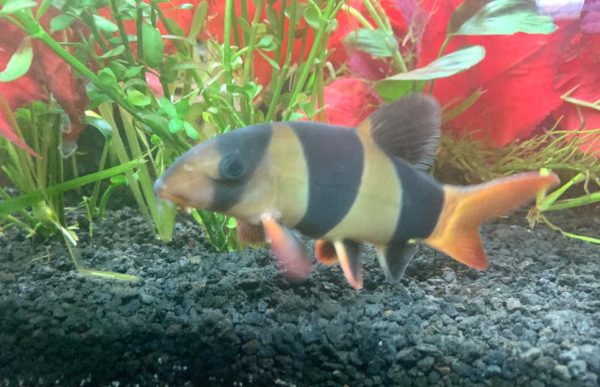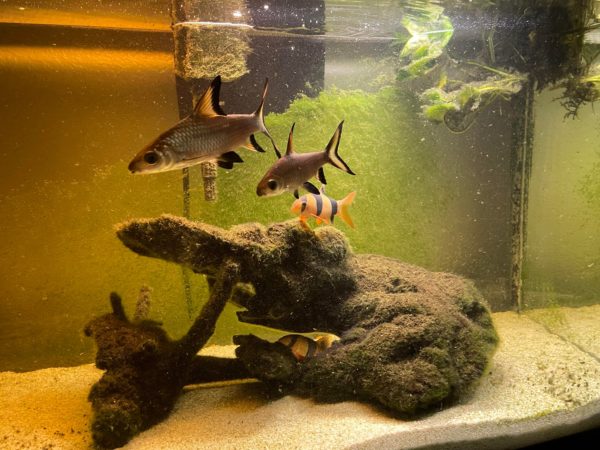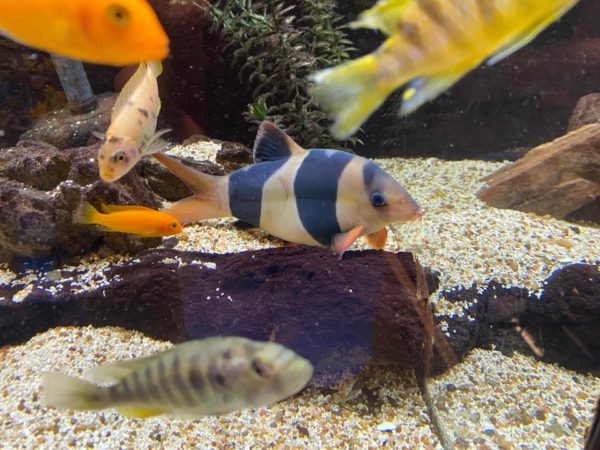Table of Contents
Clown Loach: Overview
Clown Loach is a kind of schooling fish. When arranged in groups of four or five, they create a gorgeous tableau. The fish may be fascinating if kept in the proper aquarium conditions. It can readily coexist with other fish species of the same temperament because it is a peaceful tank animal.
| Information Chart | Clown Loach |
| Scientific Name: | Chromobotia macracanthus |
| Family: | Botiidae |
| Care Level: | Intermediate |
| Temperament: | Calm |
| Color: | Orange, Yellow, Black Stripes |
| Lifespan: | Around 10 years |
| Size: | 6 inches (15~ cm) to 8 inches (20~ cm) |
| Diet: | Omnivores that feed on both plants and flesh. They accept a variety of feeds though prefer live foods. |
| Minimum Tank Size: | 55 Gallons for one fish, 100 gallons for a small school |
| Temperature: | Between 75 and 81 Fahrenheit |
| Water Conditions: | pH of 6.0- 6.5, Soft water between 5 and 12dGH |
| Tank Mate Compatibility | Bristlenose Pleco Kuhli Loach Neon Tetra Cherry Barb Tiger Barb Bolivian Ram Angelfish Black Skirt Tetra |
Clown Loach Appearance
The fish has a long, slender profile that aids it in gliding through water. Bright orange and yellow markings are strewn across its body, separated by three black stripes. They’re frequently confused with tiger barbs.

The fish notices a long, sharply pointed nose. Barbels surround it. There are protective spines beneath each eye. These are employed as a means of defense. Unfortunately, they also serve as an eye shield and can sting pretty intensely. This is cause enough to exercise caution when handling the animal with your hands.
The fins and tail of the loach are also vivid red. A long black stripe runs from the body’s sides to the eye. The pelvic fin, like the fluke, is red and black. This ability allows the fish to hide in plants and avoid predators.
In addition, the fish has a pointed mouth that extends outwards. This characteristic aids it in digging beneath the substrate in search of nourishment.
The lifespan of a Clown Loach
The typical lifespan of a Clown Loach is around 10 years. The life expectancy of this fish is affected by a variety of circumstances. This species can even live for up to 25 years in perfect natural conditions! Their life, however, can be cut short with poor care or neglect. Make sure you take care of them properly to ensure a long and happy life.
Clown Loach Size
The typical Clown Loach typically grows up to 6 inches (15~ cm) on the lower end and 8 inches (20~ cm) for larger specimens.
Clown Loaches develop at a moderate yet consistent rate. This implies that if you start them off with a smaller tank when they’re younger, you won’t have much time before you upgrade them.
Natural Habitat and Origin
The Clown Loach, or Botia Macracantha as scientifically named, made its debut in 1852. The fish was given the name clown loach by a Dutch doctor called Peter Bleeker after noticing its specific traits. Maurice Kottelat, a Swiss ichthyologist, later modified this in 2004. Maurice recognized the fish as distinct from common loaches, who designated the family Chromobotia.
The Clown loach is found in Malaysian, Kalimantan, Sumatra, and Borneo streams. It lives in the tributaries of rivers. When flooding occurs, however, it migrates to smaller rivers and streams. During spawning, it also migrates upstream.
The fish favors slow-moving waterways with overhanging trees in its natural habitat. The water in these types of environments is frequently muddy and appears tea-colored. In addition, these streams are likely to be lined with plants, twigs, and fallen leaves.
Clown Loach Care & Tank Set-Up
Clown Loach care is simple because these fish can adapt to a wide range of aquarium conditions.
They aren’t as picky as some other species. As a result, this species can cope with minor environmental changes without serious issues.
However, delivering the best possible treatment is always critical. The goal is to create an environment where these fish can live long and happy lives. To do so, follow the care instructions listed below.
Clown Loach Tank Size and Specifications
Optimum Tank Size for Clown Loach

The recommended tank size for Clown Loaches is at least 100 gallons. This tank size is perfect for a school of five or six Loaches. Clown loaches are active fish that move quickly. Therefore, we recommend a large tank. If you want to keep a solitary CLown Loach in your tank, a 55-gallon tank is enough. This is not ideal since they are used to swimming around towards the bottom of the tank in shoals.
Tank Shape for Clown Loach
You can get a tank of any shape for Clown Loaches. All you need to do is make sure that it’s not too narrow. Since the fish swim towards the bottom, they need broader and wider spaces to explore together. So a square tank is ideal, but not compulsory.
Filter Type
To keep the tank clean, you need to invest in a powerful filter such as a sump-style one or a canister filter. The Clown Loach needs pristine water conditions to thrive and live a happy life. So make sure you get a good filter and clean it out regularly.
Substrate
The Clown Loach is found in sluggish rivers with sandy beds. To replicate that, add large gravel and fine sand at the bottom of the tank. Gravel can be coated white or dyed with other colors for a more appealing appearance.
How many Clown Loach can live in a 70-gallon tank?
A small group of about five juvenile Clown Loaches can live in a 70-gallon tank. However, we recommend using a tank of at least 100 gallons. This will give your fishes plenty of room to grow.
Water Parameters for Clown Loach
Water quality is the most crucial factor to consider while caring for any fish. Only when your fish are in the appropriate surroundings can they stay healthy. Fortunately, controlling water parameters is one of the most straightforward aspects of Clown Loach care.
- Use soft water between 5 and 12dGH
- pH of 6.0- 6.5 should be ideal
- Ensure the water parameters are sustained so that the fish remains healthy and playful
Water Temperature
The ideal water temperature for Clown Loaches is 24 and 27 degrees Celsius (75 and 81 Fahrenheit). When you change the tank water, ensure that the new water has the same temperature as the old one.
Water Flow Rate
Clown Loaches prefer a fast-flowing water environment. By placing a good pump in the tank, you may achieve a high water flow rate.
pH Level
The perfect water pH level for Clown Loach is 6.0- 6.5. This mimics their natural habitat.
Water Hardness
The Clown Loach needs relatively soft water. Use water that is between 5 and 12 dGH. This is the best level for this fish to be healthy.
Clown Loach Tank Landscape
To make any fish feel at home, you just have to make your tank feel like their natural habitat. The Clown Loach is no different.

Best Plants for Clown Loach Tanks
Floating plants are the best choice for bottom-dwelling fish. Clown Loaches can wreak havoc on other plants’ roots. Here are some examples of the plants that are best suited to this fish:
- Taxiphyllum
- Anubias
- Microsorum Pteropus
- Java Moss
- Water Spangles
- Amazon sword
- Riccia Fluitans
Worst Plants for Clown Loach Tanks
Live plants requiring their root systems to be firmly planted in the soil might not be the best idea for this fish. Since they are bottom dwellers, the Clown Loach does not do well with plants that obstruct their path.
Decorations for Clown Loach Tanks
The first reminder is that you can not add sharp decorations at the bottom. The Clown Loach is a bottom dweller and might be injured by sharp things.
Add enough caverns and rocks to provide them with lots of hiding spots. Fish enjoy hiding and seeking among these big structures, so adding items like a small plant or a bright stone keeps them occupied. They’ll also have a variety of hiding spots that mimic their natural surroundings.
Lighting for Clown Loach Tanks
You should provide a low-light environment. They are shy little creatures who are more active in the dark than in light. Because the fish is an energetic swimmer, you should give a high water flow and good aeration. You should implement weekly water changes to keep the water fresh and the fish safe. On occasion, you may use bluish light to encourage the fish to emerge from its hiding place. This might be a lot of fun.
Feeding Clown Loach
Clowns are omnivores that feed on both plants and flesh. They accept a variety of feeds, though they prefer live foods.
Best Diet for Clown Loach
The fish can heartily appreciate the gesture if you can harvest worms from the vegetable garden. However, do not include any worms from recently fertilized soil. Other feeds for the loach include:
- Vegetables
- Squash
- Lettuce
- Cucumber
- Shrimp wafers
- Food pellets

How often should you feed Clown Loaches?
The Clown Loach should typically be fed twice a day. To keep the fish healthy and active, switch up the food.
Clown Loach Behaviour and Temperament
Clown Loaches are calm and laid-back. They usually stay in the aquarium’s middle and lower levels. On the other hand, these fish may live alongside most calm species (even ones that dwell in the same areas of the tank).
When the lighting is low, these fish are at their most active. It also makes a buzzing noise that may initially annoy a pet owner. Another intriguing tactic the fish uses to ward off would-be predators is this. It also uses it to frighten creatures it thinks to be food. The main disadvantage of this sound is that it only lasts a few seconds. It takes a highly sharp person to figure it out.
Loaches in their infancy are known for being incredibly active and amusing. However, as people grow older, they develop a sense of complacency.
The loach has a habit of being missing for several days. It can hide in one of the caverns or behind java fern bushes. This may cause panic, but it is pretty natural.
Is the Clown Loach lone or societal?
Clown loaches are thought to be a schooling species. The fish will swim around and chase each other if maintained in groups. It’s an entertaining action to observe!
Unfortunately, their social behavior tends to disappear when they are not in groups. Fish maintained alone or in small groups are more cautious and skittish.
Clown Loach Tank Mates
Ideal Clown Loach Tank Mates
They are generally calm and can be kept with other friendly fish. Others of the same species will make the greatest Clown Loach tank mates. You should own at least five fish together. Some ideal tank mates are:
- Bristlenose Pleco
- Kuhli Loach
- Neon Tetra
- Cherry Barb
- Tiger Barb
- Bolivian Ram
- Angelfish
- Black Skirt Tetra

Bad Tank Mates for Clown Loach
Cichlids are not the best company for these fish. Other peaceful species are great for them. Also, please do not keep them in a tank with snails. Sometimes, Clown Loaches tend to eat snails.
Breeding Clown Loach
In captivity, breeding the fish is a difficult task. Another difficult decision is separating the sexes. However, for the purposes of testing, one may do the following:
- Observe the movement and activity of many loaches in a tank.
- Those that have active reproductive characteristics should be placed in a separate tank.
- Adults should be removed from the tank after spawning because they eat their own eggs.
- The eggs should be able to hatch within a few days.
- Fry normally eat on egg sacs for the first few days. They can be fed young brine shrimp as they get older. They can be exposed to different feeds later.
- It’s difficult to raise the fry. Many of them will almost certainly perish along the route.
Clown Loach Breeding Level – Hard
Clown Loach Sexual Dimorphism?
To distinguish between male and female Clown Loaches, we must observe the body size and the types of marking on their body. Clown Loaches are sexually dimorphic. Males are usually more brilliant and colorful than females. They also have a longer, more exaggerated “V”-shaped tail. Females, on the other hand, are usually slightly plumper.
Clown Loach Common Diseases and their Treatment
All of the common tropical freshwater fish illnesses can affect clown loaches.
They are, however, particularly vulnerable to Ich.
- Ich
Lethargy, loss of appetite, restless activity, and, most significantly, white spots on the fish’s body are all signs. When they’re in the proper water, this disease will be gone.
You must, however, be careful. Clown loaches are susceptible to a wide range of drugs. Most owners will only give half of the recommended dosage to avoid difficulties. Read the medication directions carefully to ensure that you’re treating your fish safely.
Facts about Clown Loach
- The Clown loach is found in Malaysian, Kalimantan, Sumatra, and Borneo streams. It lives in the tributaries of rivers.
- When flooding occurs, it migrates to smaller rivers and streams. During spawning, it also migrates upstream.
- Slow-moving waterways with overhanging branches are preferred by the fish. The water in these types of environments is frequently muddy and appears tea-colored.
- They are relatively calm and can be kept alongside other peaceful fish such as giant tetras, swordtails, rope fish, and African cichlids.

FAQs
What should the size of a Clown Loach tank be?
If you want this fish in your tank, you’ll need a small school of them. Get a 100-gallon tank for around 5 fish. They are bottom-dwellers but need lots of space to explore.
What is the maximum size of a Clown Loach?
When fully mature, a Clown Loach can reach a length of 12 inches. Although they are supposed to grow a little longer in the wild, most fish in captivity will reach this length.
What is the lifespan of a Clown Loach?
In captivity, a Clown Loach can live for at least ten years. The life expectancy of this fish is affected by a variety of circumstances. This species is said to live up to 25 years in perfect natural conditions!

1 thought on “Clown Loach: Care Guide, Breeding, Tank Size, and Disease”
Thanks for putting this valuable information on the clown loach. I love clowns but have been unsuccessful keeping them longer than (approximately) two years. They end up with “skinny disease” where they waste away despite eating normally. I’m at my wits end battling the parasite living inside the loach. Any thoughts with controlling this disease? Thank you.